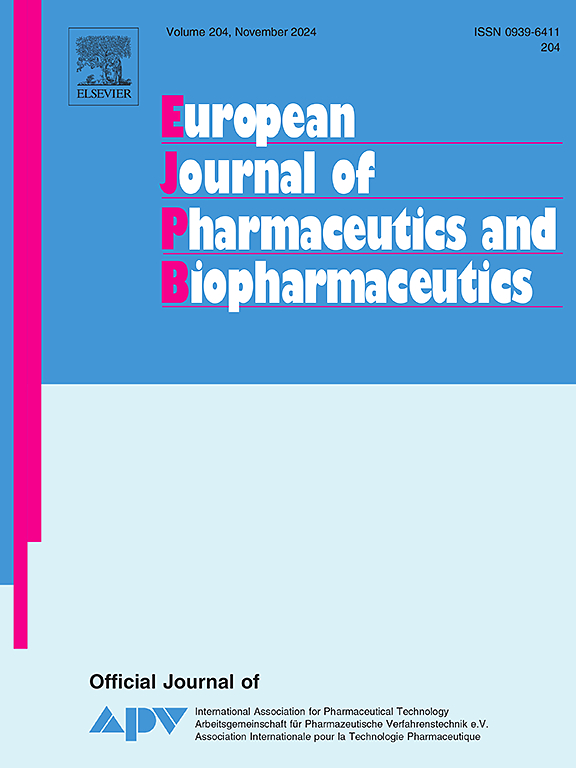Flexipill: A novel 3D printed flexible dose combination for hypertension with a floating element
IF 4.4
2区 医学
Q1 PHARMACOLOGY & PHARMACY
European Journal of Pharmaceutics and Biopharmaceutics
Pub Date : 2025-05-08
DOI:10.1016/j.ejpb.2025.114736
引用次数: 0
Abstract
Hypertension is highly prevalent worldwide, affecting approximately one in three adults. The pathophysiology of hypertension is multifactorial, which led recent guidelines to recommend the initiation of treatment with more than one antihypertensive agent. This exacerbates the existing issue of polypharmacy, particularly among geriatric patients. Polypharmacy can lead to a reduction in patient adherence to the treatment. As a result, many clinical studies have investigated using fixed-dose combinations to address this issue. These studies have demonstrated the effectiveness of a polypill in improving patient adherence. However, a polypill limits the flexibility for dose titration and personalisation of treatment. Therefore, when 3D printing was first introduced to pharmaceutical formulation, researchers recognised the potential of this technology for drug personalisation and the creation of more flexible drug combinations. Nonetheless, regulatory concerns still limit the translation of these research efforts into clinical applications that can benefit the patient. Consequently, this study seeks to bridge the existing gap by identifying a balanced approach between regulatory requirements and the concept of personalised drug combinations.
The Flexipill is a flexible dose combination that does not require printing at the pharmacy level. It can be printed at a quality-controlled facility and assembled according to patient needs at the point of care. In this work, an antihypertensive Flexipill was printed, with each unit having different drug release profiles and formulation requirements. The propranolol HCl unit was printed as a floating unit to improve its solubility and bioavailability. It floated for 9 h, releasing over 90 % of the drug content. The enalapril maleate unit was formulated to avoid thermal degradation by printing at 150 °C, which is lower than its degradation temperature. Moreover, hydrochlorothiazide was formulated to provide immediate release of over 90 % of the drug within the first hour.

flexpill:一种新型的3D打印灵活剂量组合,用于治疗高血压,带有浮动元件
高血压在世界范围内非常普遍,大约三分之一的成年人受其影响。高血压的病理生理是多因素的,这导致最近的指南建议开始使用一种以上的抗高血压药物。这加剧了现有的多药问题,特别是在老年患者中。多种用药可导致患者对治疗的依从性降低。因此,许多临床研究调查了使用固定剂量组合来解决这一问题。这些研究证明了复方药片在提高患者依从性方面的有效性。然而,复方药片限制了剂量滴定和个性化治疗的灵活性。因此,当3D打印首次引入药物配方时,研究人员认识到这项技术在药物个性化和创造更灵活的药物组合方面的潜力。尽管如此,监管方面的担忧仍然限制了这些研究成果转化为对患者有益的临床应用。因此,本研究试图通过确定监管要求和个性化药物组合概念之间的平衡方法来弥合现有的差距。flexpill是一种灵活的剂量组合,不需要在药房级别打印。它可以在质量控制的设施中打印,并根据患者的需要在护理点组装。在这项工作中,打印了一种抗高血压的flexpill,每个单元具有不同的药物释放曲线和配方要求。以盐酸心得安为浮动单元,提高其溶解度和生物利用度。漂浮9小时,释放90%以上的药物含量。通过在低于其降解温度的150℃下印刷,制备了马来酸依那普利单元以避免热降解。此外,配制氢氯噻嗪可在第一个小时内立即释放90%以上的药物。
本文章由计算机程序翻译,如有差异,请以英文原文为准。
求助全文
约1分钟内获得全文
求助全文
来源期刊
CiteScore
8.80
自引率
4.10%
发文量
211
审稿时长
36 days
期刊介绍:
The European Journal of Pharmaceutics and Biopharmaceutics provides a medium for the publication of novel, innovative and hypothesis-driven research from the areas of Pharmaceutics and Biopharmaceutics.
Topics covered include for example:
Design and development of drug delivery systems for pharmaceuticals and biopharmaceuticals (small molecules, proteins, nucleic acids)
Aspects of manufacturing process design
Biomedical aspects of drug product design
Strategies and formulations for controlled drug transport across biological barriers
Physicochemical aspects of drug product development
Novel excipients for drug product design
Drug delivery and controlled release systems for systemic and local applications
Nanomaterials for therapeutic and diagnostic purposes
Advanced therapy medicinal products
Medical devices supporting a distinct pharmacological effect.

 求助内容:
求助内容: 应助结果提醒方式:
应助结果提醒方式:


